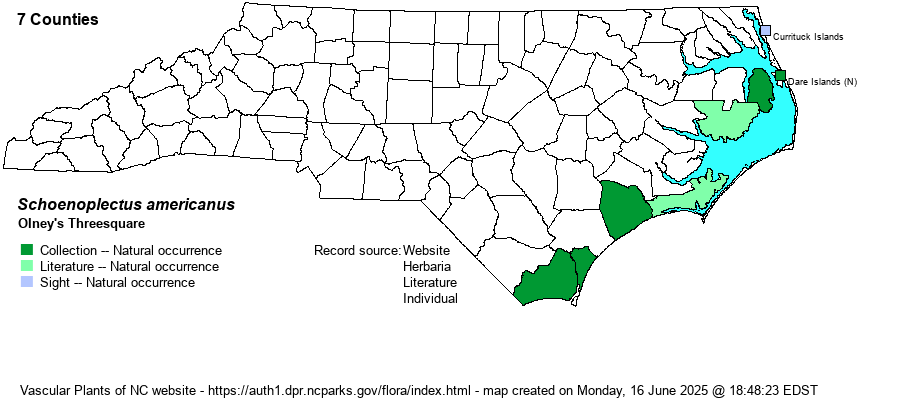| Author | (Persoon) Volk ex Schinzius & R. Keller | |
| Distribution | Outer Coastal Plain and northern Outer Banks.
N.S. to WA south to South America. In the eastern U.S., mainly coastal; occurs well inland across much of the Western states. | |
| Abundance | Uncommon on the landscape, but locally numerous. Plants usually are colonial and form stands or patches. It often occurs with or near S. pungens. The website editors recommend a State Rank of S2S3, as the NCNHP's rank of S1? is certainly too conservative. It is a Watch List species. | |
| Habitat | Brackish or fresh-tidal marshes, above the zone of Black Needlerush (Juncus roemerianus). |
| Phenology | Flowering and fruiting June-September. | |
| Identification | The leafless stems are sharply triangular in cross-section and grow 4-7 feet tall. Near the summit of each stem is a single compact cluster of spikelets, with an erect bract that looks as if it were a continuation of the stem. It is very much like Common Threesquare (S. pungens), but the color of C. americanus is brighter green, the stems are sharply triangular (vs. much less sharply angled in that species), and the inflorescence bracts are shorter (1-6 cm long vs. 3-20 cm long). | |
| Taxonomic Comments | The name Scirpus americanus only applies to what used to be called S. olneyi, due to a misidentification of the type specimen.
The genus Schoenoplectus has been split from Scirpus and includes plants with sessile spikelets, or with spikelets with a few branches (vs. open, widely branching inflorescences). Most of our Schoenoplectus species appear to have no leaves (exceptions are S. etuberculatus and S. subterminalis), whereas Scirpus taxa have well-developed basal and stem leaves. | |
| Other Common Name(s) | Chairmaker's Bulrush | |
| State Rank | S1? [S2S3] | |
| Global Rank | G5 | |
| State Status | W7 | |
| US Status | | |
| USACE-agcp | OBL link |
| USACE-emp | OBL link |

